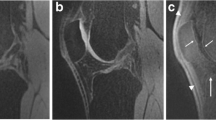Abstract
Purpose
To compare knee MRI performed with the integrated parallel acquisition technique (PAT) and simultaneous multislice (SMS) turbo spin echo (TSE) T2-weighted (T2w) sequences with conventional TSE sequences in pediatric patients.
Materials and methods
This was a retrospective IRB-approved study. Seventy-four subjects (26 male, 48 female, mean age 15.3 years, range 8–20) underwent 3-T MRI of the knee with a T2w TSE pulse sequence prototype with four-fold PAT and SMS acceleration as well as the standard PAT-only accelerated sequences. Images were anonymized and two study folders were created: one examination with only T2w PAT2 images (conventional examination) and one examination with only T2w SMS2/PAT2 sequences (SMS examination). Two readers rated examinations for 15 specific imaging findings and 5 quality metrics. Interreader agreement was measured. Signal to noise (SNR) and contrast to noise (CNR) were measured for SMS and conventional T2w sequences.
Results
Consensus review demonstrated diagnostic quality performance of SMS examinations with respect to all 15 structures. Average area under the curve (AROC) was 0.95 and 0.97 for readers 1 and 2, respectively. The conventional sequence was favored over SMS for four out of five quality metrics (p < 0.001). SNR and CNR were higher for the conventional sequences compared to SMS.
Conclusion
SMS accelerated T2w TSE sequences offer a faster alternative for knee imaging in pediatric patients without compromise in diagnostic performance despite diminished SNR. The four-fold acceleration of SMS is beneficial to pediatric patients who often have difficulty staying still for long MRI examinations.






Similar content being viewed by others
References
Adirim TA, Cheng TL. Overview of injuries in the young athlete. Sports Med. 2003;33(1):75–81.
Sanchis-Gimeno JA, Casas-Roman E, Garcia-Campero C, Hurtado-Fernandez R, Aparicio-Bellvar L. Anatomical location of athletic injuries during training: a prospective two year study in 2701 athletes. Br J Sports Med. 2005;39(7):467.
Vincken PW, ter Braak AP, van Erkel AR, et al. MR imaging: effectiveness and costs at triage of patients with nonacute knee symptoms. Radiology. 2007;242:85–93.
McNally EF, Nasser KN, Dawson S, Goh LA. Role of magnetic resonance imaging in the clinical management of the acutely locked knee. Skelet Radiol. 2002;31:570–3.
Maurer EJ, Kaplan PA, Dussault RG, et al. Acutely injured knee: effect of MR imaging on diagnostic and therapeutic decisions. Radiology. 1997;204:799–805.
Griswold MA, Jakob PM, Heidemann RM, et al. Generalized autocalibrating partially parallel acquisitions (GRAPPA). Magn Reson Med. 2002;47:1202–10.
Setsompop K, Gagoski BA, Polimeni JR, Witzel T, Wedeen VJ, Wald LL. Blipped-controlled aliasing in parallel imaging (blipped-CAIPI) for simultaneous multi-slice EPI with reduced g-factor penalty. Magn Reson Med. 2012 May;67(5):1210–24.
Fritz J, Fritz B, Zhang J, Thawait GK, Joshi DH, Pan L, Wang D. Simultaneous multislice accelerated turbo spin echo magnetic resonance imaging: Comparison and combination with in-plane parallel imaging acceleration for high-resolution magnetic resonance imaging of the knee. Invest Radiol 2017.
Larkman DJ, Hajnal JV, Herlihy AH, Coutts GA, Young IR, Ehnholm G. Use of multicoil arrays for separation of signal from multiple slices simultaneously excited. J Magn Reson Imaging. 2001;13:313–7.
Moeller S, Yacoub E, Olman CA, Auerbach E, Strupp J, Harel N, et al. Multiband multislice GE-EPI at 7 Tesla, with 16-fold acceleration using partial parallel imaging with application to high spatial and temporal whole-brain fMRI. Magn Reson Med. 2010;63:1144–53.
Barth M, Breuer F, Koopmans PJ, Norris DG, Poser BA. Simultaneous multislice (SMS) imaging techniques. Magn Reson Med. 2016;75:63–81.
Breuer FA, Blaimer M, Heidemann RM, Mueller MF, Griswold MA, Jakob PM. Controlled aliasing in parallel imaging results in higher acceleration (CAIPIRINHA) for multi-slice imaging. Magn Reson Med. 2005;53:684–91.
Bidgood WD Jr, Horii SC. Introduction to the ACR-NEMA DICOM standard. Radiographics. 1992;12:345–55.
Coupé P, Yger P, Prima S, Hellier P, Kervrann C, Barillot C. An optimized blockwise nonlocal means denoising filter for 3-D magnetic resonance images. IEEE Trans Med Imag. 2008;27:425–41.
Coupé P, Manjón JV, Gedamu E, Arnold D, Robles M, Collins DL. Robust Rician noise estimation for MR images. Med Imag Anal. 2010;14:483–93.
Agresti A. Categorical data analysis. Third ed. New York: John Wiley & Sons; 2013.
Cicchetti DV. Guidelines, criteria, and rules of thumb for evaluating normed and standardized assessment instruments in psychology. Psychol Assessment. 1994;6(4):284–90.
Swets JA. Measuring the accuracy of diagnostic systems. Science. 1988;240:1285–93.
SAS Institute Inc. SAS/STAT® 14.1 User Guide. Cary, NC: SAS Institute Inc; 2015.
Paterson N, Waterhouse P. Risk in pediatric anesthesia. Paediatr Anaesth. 2011;21:848–57.
Cravero JP, Beach ML, Blike GT, Gallagher SM, Hertzog JH, Pediatric Sedation Research Consortium. The incidence and nature of adverse events during pediatric sedation/anesthesia with propofol for procedures outside the operating room: a report from the pediatric sedation research consortium. Anesth Analg. 2009;108:795–804.
DiMaggio C, Sun LS, Kakavouli A, Byrne MW, Li G. A retrospective cohort study of the association of anesthesia and hernia repair surgery with behavioral and developmental disorders in young children. J Neurosurg Anesthesiol. 2009;21:286–91.
Rappaport BA, Suresh S, Hertz S, Evers AS, Orser BA. Anesthetic neurotoxicity—clinical implications of animal models. N Engl J Med. 2015;372(9):796–7.
Fabricant PD, Kocher MS. Anterior cruciate ligament injuries in children and adolescents. Orthop Clin North Am. 2016;47(4):777–88.
Lawrence JT, Argawal N, Ganley TJ. Degeneration of the knee joint in skeletally immature patients with a diagnosis of an anterior cruciate ligament tear: is there harm in delay of treatment? Am J Sports Med. 2011;29(12):2582–7.
Davis DL, Chen L, Ehinger M. A study of epiphyses in the young prepubescent knee using magnetic resonance imaging. Orthop J Sports Med. 2014;2(4):2325967114530090.
Oeppen RS, Connolly SA, Bencardino JT, Jaramillo D. Acute injury of the articular cartilage and subchondral bone: a common but unrecognized lesion in the immature knee. Am J Roentgenol. 2004;182(1):111–7.
Author information
Authors and Affiliations
Corresponding author
Ethics declarations
Conflict of interest
The authors declare that they have no conflict of interest.
Rights and permissions
About this article
Cite this article
Benali, S., Johnston, P.R., Gholipour, A. et al. Simultaneous multi-slice accelerated turbo spin echo of the knee in pediatric patients. Skeletal Radiol 47, 821–831 (2018). https://doi.org/10.1007/s00256-017-2868-2
Received:
Revised:
Accepted:
Published:
Issue Date:
DOI: https://doi.org/10.1007/s00256-017-2868-2




